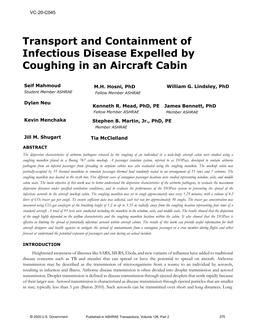Description
The dispersion characteristics of airborne pathogens released by the coughing of an individual in a wide-body aircraft cabin were studied using a coughing manikin placed in a Boeing 767 cabin mockup. A passenger isolation system, referred to as ISOPass, developed to contain airborne pathogens from an infected passenger from spreading in airplane cabins was also evaluated using the coughing manikin. The mockup cabin was partially-occupied by 55 thermal manikins to simulate passenger thermal load randomly seated in an arrangement of 11 rows and 7 columns. The coughing manikin was located in the sixth row. Five different cases of contagious passenger locations were studied representing window, aisle, and middle cabin seats. The main objective of this work was to better understand the dispersion characteristics of the airborne pathogens, to evaluate the maximum dispersion distances under specified ventilation conditions, and to evaluate the performance of the ISOPass system in preventing the spread of the infectious aerosols in the aircraft mockup cabin. The coughing manikin was set to cough approximately once every 1.25 minutes, with a volume of 4.2 liters of CO2 tracer gas per cough. To ensure sufficient data was collected, each test ran for approximately 30 coughs. The tracer gas concentration was measured using CO2 gas analyzers at the breathing height of 1.2 m up to 3.35 m radially away from the coughing location representing four rows of a standard aircraft. A total of 93 tests were conducted including the manikin in the window, aisle, and middle seats. The results showed that the dispersion of the cough highly depended on the airflow characteristics and the coughing manikin location within the cabin. It also showed that the ISOPass is effective in limiting the spread of potentially infectious aerosols within aircraft cabins. The results of this work can provide useful information for both aircraft designers and health agencies to mitigate the spread of contaminants from a contagious passenger or a crew member during flights and either forecast or understand the potential exposure of passengers and crew during an actual incident.
Citation: 2020 Virtual Conference Papers
Product Details
- Published:
- 2020
- Number of Pages:
- 9
- Units of Measure:
- Dual
- File Size:
- 1 file , 2.1 MB
- Product Code(s):
- D-VC-20-C045




